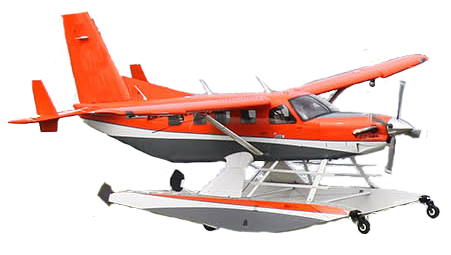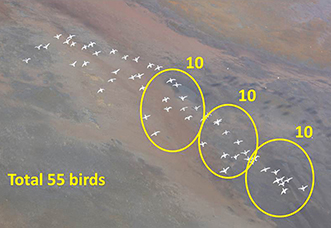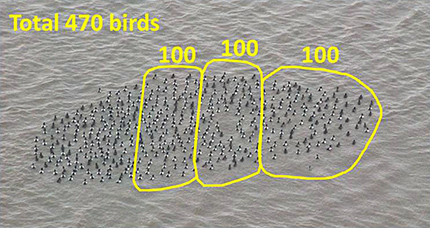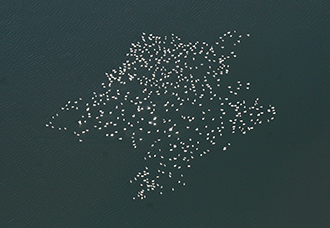Estimating Flock Size
| Watch narrated video about counting birds in flocks. [High internet speed] [Low internet speed] | |||||
|
While aerial surveys during the breeding season are usually targeting pairs or small groups of waterfowl, surveys during the non-breeding season, such as during winter, molt, and on staging areas, often require observers to estimate the number of birds in flocks. Accurately counting the number of birds in flocks can be difficult - it's a skill that takes practice. The tendency of most observers is to underestimate the number of birds in a flock and usually, the larger the flock, the less accurate (and low biased) the estimates are. One technique that is often used by observers to visually count birds in flocks is to visually break the flock into units of 10, or 100, or 1000, and then estimate the number of "units" within the flock. The first step is learning how to accurately estimate these smaller units. You want to get a sense of what 10 birds looks like, and visually pick out another 10, then another, until you've counted the entire flock. Once you've mastered the 10-count, then try to get a feel for what 100 birds looks like, and break larger flocks into 100-bird "chunks". However, it's prudent to initially start with 10-counts because flock densities vary and can affect your perception of numbers of birds.
This takes considerable practice to get good at it, and it's best practiced before you try to do it from a plane flying low-level at 100 mph. It will be important to practice using the features included in this Guide and the testing features on this web site until you're able to make the visual estimates fairly quickly while retaining accuracy. Some duck species are sexually dimorphic (in other words, males are brightly colored and females are mostly brown). In those flocks, males are far more obvious and there's a tendency to "miss" the darker females, thus underestimating the true number of birds. For example, here are two photos of flocks - the left photo is of snow geese where males and females have similar plumage. The right photo is of spectacled eiders with whitish males and brownish females. The number of birds in each flock is equal, although it seems like there are more snow geese.
When we look closer at the eiders, you can see that there are in fact many brown females in the flock, but the white plumage of the males swamps the initial visual image so you don't see the females as readily, and likely underestimate the total number of birds.
The magnitude of this bias is dependent on the sex ratio within the flock - for example, flocks composed of predominantly males will have relatively less bias than a flock with a more even, or female-skewed, mix of white males and brown females. In addition to plumage factors, the perception of number of birds can also be influenced by the density of birds in a flock, contrast with the background environment (land vs sea, sea state, glare), the distributional pattern of the flock (clumped versus linear), and the observer's perspective (near-vertical vs varying degrees of obliqueness). When you encounter large flocks (many hundreds or thousands), it's often better to fly at higher altitude and estimate from a height where you have more time to see the entire flock, and less likelihood of causing birds to flush or dive in response to the aircraft. For flocks with birds numbering in the thousands or tens of thousands, aerial photography should be considered as a more efficient and accurate way of estimating numbers of birds. In the Test Your Counting Skills section, you will have an opportunity to test and hone your ability to accurately and consistently estimate numbers of birds in flocks. Other Resources Hodges, J. I. 2014. Wildlife Counts: A computerized simulation for learning the skill of wildlife count estimation. www.wildlifecounts.com. |







